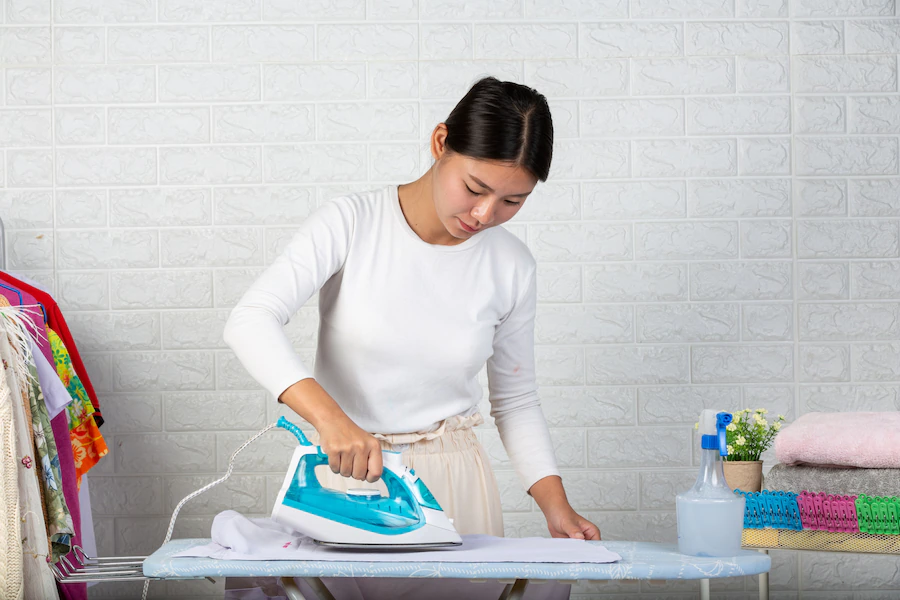
with the heavy fabrics, move on to lighter materials such as polyester, silk, and wool. These fabrics require a lower heat setting on your iron, so be sure to adjust it accordingly. Finally, ensure that your iron is unplugged and allow it to cool completely before storing it away.
How to Iron Delicate Fabrics
When dealing with very delicate fabrics like lace or wool, take a few extra precautions when ironing.
1. Ensure your iron is set to the appropriate setting. Lace and wool can be easily damaged by too much heat, so always err on the side of caution.
2. Have a pressing cloth on-hand. A pressing cloth is a piece of fabric you place between your garment and the iron, protecting the fabric from damage.
3. Finally, be sure to iron on the wrong side of the fabric. This will help to prevent any shiny marks or imprints from being left on the right side of the fabric.
How to Iron Shirts
Ironing shirts isn’t complicated but there are a few key things to keep in mind when ironing a shirt. If you’re looking to get those crisp, clean lines on your shirt collar and cuffs, you need to iron them properly.
1. Start by setting up your ironing board in a well-lit area. Make sure the board is covered with a clean, smooth surface like a thin cotton sheet.
2. Next, plug in your iron and set it to the appropriate fabric heat you’re working with. Refer to the care label on your garment for guidance.
3. Once the iron is heated, begin by ironing the collar of your dress shirt. Then, proceed to iron sleeves from the cuffs and onto the shoulder. Be sure to open up the collar and cuffs so that you can get a good, smooth press.
4. Continue by ironing the front and back panels of your shirt. Pay special attention to areas that tend to crease, such as around those delicate buttons.
5. When you’re finished, hang your shirt up or fold it neatly, so it doesn’t wrinkle again. Enjoy your well-ironed garment!
How to Iron Pants
Ironing pants should only take a few minutes once you have the basics down. Start by hanging your pants up on a clothesline or hanger to remove any wrinkles that may have already set in.
1. First, fill a spray bottle with water and lightly mist the pants. Be sure not to over-saturate the fabric.
2. Now, lay the pants flat on a board and iron them using a medium heat setting. Start at the waistband and work your way down to the hem.
3. Once you’ve finished ironing both legs, move on to the seat of the pants. Again, start at the waistband and work your way down.
4. Finally, iron your creases in the leg areas. If necessary, use your iron’s steam function to help remove stubborn wrinkles.
And there you have it! Now you know how to iron pants like a pro.
How to Iron Skirts & Dresses
Skirts may appear easy at first glance, but the trouble starts with the pleats, ruffles, and other details. Dresses often have collars and cuffs like a shirt and ruffles and gathers like a skirt. Let’s go through how to press these tricky garments:
1. If you’re ironing a dress with collars and sleeves, you’ll want to take the same steps you would for a shirt. Proceed to iron your collar, cuffs, sleeves and yoke.
2. Skirts require ironing from the bottom and work their way up to the waist. Skirts that feature ruffles and gathers require ironing inside of the skirt from the hemline and moving towards its centre. For pleats, iron from the bottom on the inside and move towards the outside of the pleat.
3. For garments with buttons, you’ll want to take extra care and iron firmly around them. Garments that have embroidered details should be pressed on the wrong side so the designs aren’t damaged. You can lay this fabric down on a cloth or tea towel to ensure its protection.
General Ironing Tips
Regardless of clothes type or fabric, there are a few general tips that will always get the best results. Let’s go over them:
Iron clothes using steam: Steam can help to remove wrinkles and soften the fabric. To use steam, fill your iron with water and set it to the steam setting. Then, hold the iron about six inches away from the clothing and let the steam do its work.
Be careful with embellishments: If your shirt has buttons or sequins, be sure to cover them with a press cloth before ironing to avoid melting or damaging them.
Always look at the tag: When ironing a suit, for example, you need to know what the fabric is made of in order to set the iron to the correct temperature. Always check the tag to find out the answer.
Invest in a cordless iron: This enhances ironing safety as there’s zero chance of someone tripping over its cord. Irons with an automatic shut off function are also ideal, as they’ll turn off the power if left inactive for too long. This is a great safety feature, especially if you have kids in the house.
Follow the grain: Finally, when ironing, always follow the grain of the fabric. This means that you should iron in the same direction as your fabric’s threads. Ironing against the grain can cause damage and make wrinkles more difficult to remove.
Hire a professional: If time is of the essence and you need last-minute bulk ironing, hire a professional ironing service. Commercial establishments, in particular, use these services to keep their employees looking sharp. Luckily, you don’t have to look far since Sidepost offers premium ironing services in Sydney, Melbourne, Hobart, Perth, Canberra, Gold Coast, Adelaide, Brisbane, and many cities across Australia.
How to Clean Your Iron
If you want your hot iron to last, and perform its best, you need to clean it regularly. Here’s how:
1. Unplug the iron and let it cool completely. Fill a sink with very hot water and add a tablespoon of baking soda. Submerge the iron in the water and let it soak for about 15 minutes.
2. Remove the iron from the water and use an old toothbrush or other soft brush to scrub away any built-up residue on the plate. Wipe it down with a clean cloth.
3. Fill the reservoir with equal parts vinegar and water. Turn on the steam setting and let the mixture steam through for a few minutes. Then empty the reservoir and rinse it out several times with plain water.
4. Wipe the outside of the iron with a damp cloth. Be sure to unplug it first!
Now your iron is clean, shiny and ready to go.
Ways to Iron Safely
Ironing is a necessary household chore, but it can be dangerous if you don’t do it safely. Here are some tips to help you iron safely:
1. Keep children and pets away from the ironing area.
2. Always use an ironing board or a flat surface such as a counter or table. Surfaces that are rough in texture, like granite or tile, can damage your clothes. However, ironing boards are built to absorb heat and are your best option.
3. Make sure the ironing board is stable and not wobbly. An unstable board can topple along with your hot iron – ouch!
4. Check your iron’s cord to make sure it is not frayed or damaged in any way. Exposed wiring is a catastrophe waiting to happen.
5. Be careful when using steam irons as steam can easily cause burns. Never point the steam holes directly at your skin and always use a press cloth when ironing over delicate fabrics.
6. Never leave an iron unattended while it is on. Turn it off and unplug it when you’re finished using it.
7. Never leave the iron too long on any type of fabrics as it will burn. Make sure to keep your iron moving to avoid this happening.
8. Do not leave the iron face down on the ironing board. Instead, always ensure to place your iron upright. Once you’re done, let the iron cool down and unplug.
Following these safety tips will help you avoid accidents when ironing. Ironing can be a chore, but it’s important to do it safely.
Frequently Asked Questions
What is the best way to store an iron?
When it comes to storing an iron, there are a few things you’ll want to keep in mind:
- Be sure to unplug the iron and allow it to cool completely before storing it.
- If your iron has a water reservoir, empty it before storing it.
- Store the iron in a dry, safe place where it won’t be jostled around or come into contact with moisture. A cabinet or closet shelf is a good option.
What clothes don’t need ironing?
A few types of clothing don’t need ironing, including most synthetic fabrics, wool, and cashmere. You can also buy wrinkle-free dress shirts made from cotton or linen. If you’re unsure whether a fabric needs ironing, check the care label; if it says “no iron” or “wrinkle free,” you’re good to go!
What are some common ironing mistakes?
One of the most common mistakes people make when ironing is using too much pressure. This can damage delicate fabrics and leave marks on the clothing. Another common mistake is not using enough heat, leaving you with a cool iron that barely does the job. Finally, people often forget to iron in the direction of the grain, which can cause damage to the fabric over time.
What is the best way to remove wrinkles from clothes?
There are several ways to remove wrinkles from clothes, including hanging them up, using a clothes steamer, or pressing them with an iron.
How do I avoid burning my clothes with the iron?
To avoid burning your clothes, be sure to set your iron to the appropriate heat setting for the fabric you’re working with and use a press cloth when necessary. Also, be sure to empty the water reservoir of your iron regularly to prevent mineral buildup.
What is the difference between an iron and a steamer?
An iron smooths out fabric by using heat to loosen the fibres, while a steamer uses steam to loosen the fibres. Both methods can be effective in removing wrinkles from clothes.
How do I prevent my clothes from getting wrinkled?
To prevent your clothes from getting wrinkled, start by choosing the right fabrics. Clothes made from natural fibres like cotton and linen are less likely to wrinkle than synthetic fabrics like polyester.
When packing for travel, roll your clothes instead of folding them to help avoid wrinkles. And be sure to remove your clothes from the dryer promptly, so they don’t have a chance to become wrinkled.
Air Conditioning ( 3 )
Blinds installation ( 3 )
Building and Pest Inspections ( 4 )
Car Detailing & Car Wash ( 3 )
Carpet Cleaning ( 3 )
Carpet Installation ( 2 )
Custom Fish Tanks ( 2 )
Dry cleaning and ironing ( 3 )
Fencing Contractors ( 5 )
House Cleaning ( 7 )
House Painting ( 6 )
Ironing Service ( 1 )
Lawn Mowing ( 3 )
Pest control ( 2 )
Pool cleaning/servicing ( 3 )
Pressure Washing ( 2 )
Uncategorized ( 6 )
Professional Home Services at your Door
Get it all done with Sidepost - House cleaning, fencing, painting, and more.

